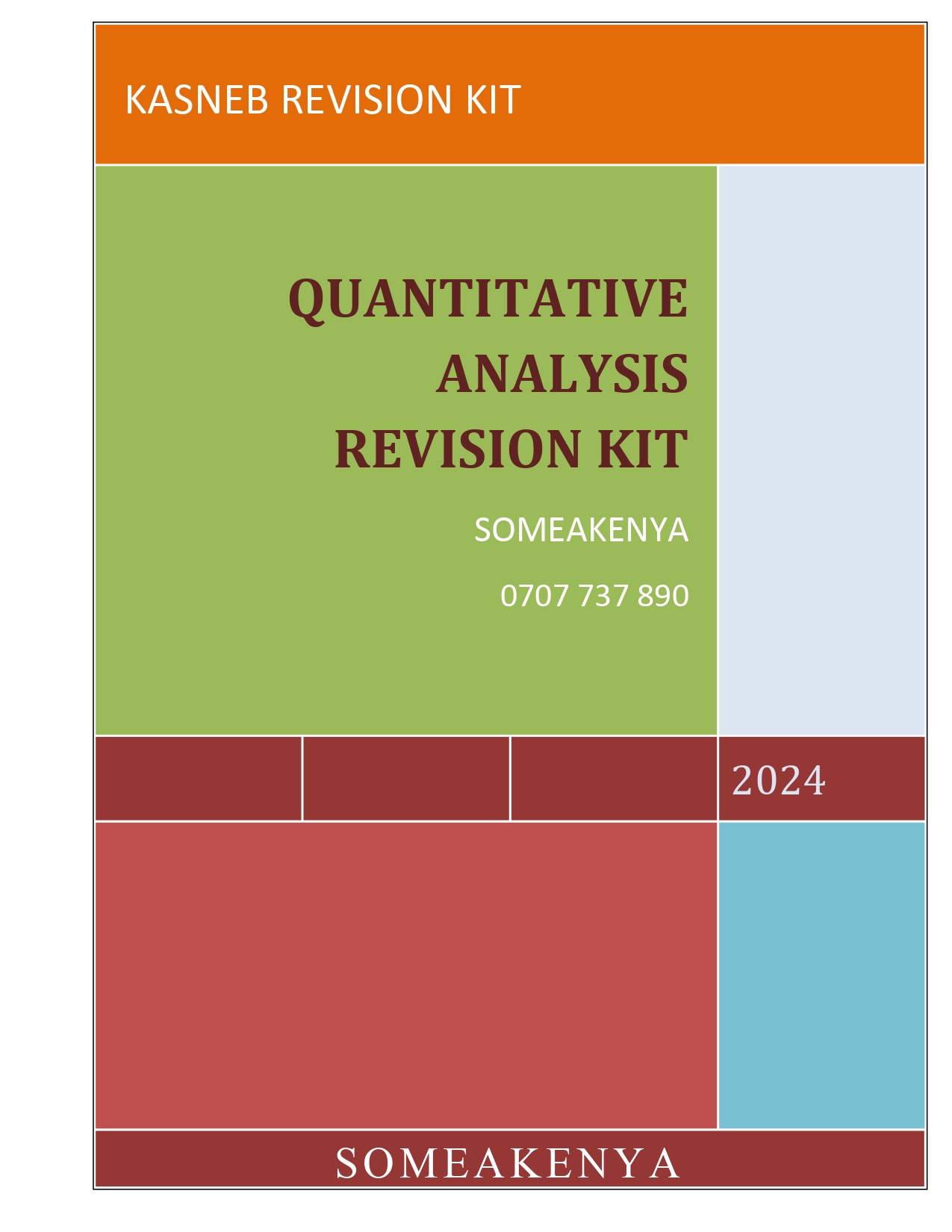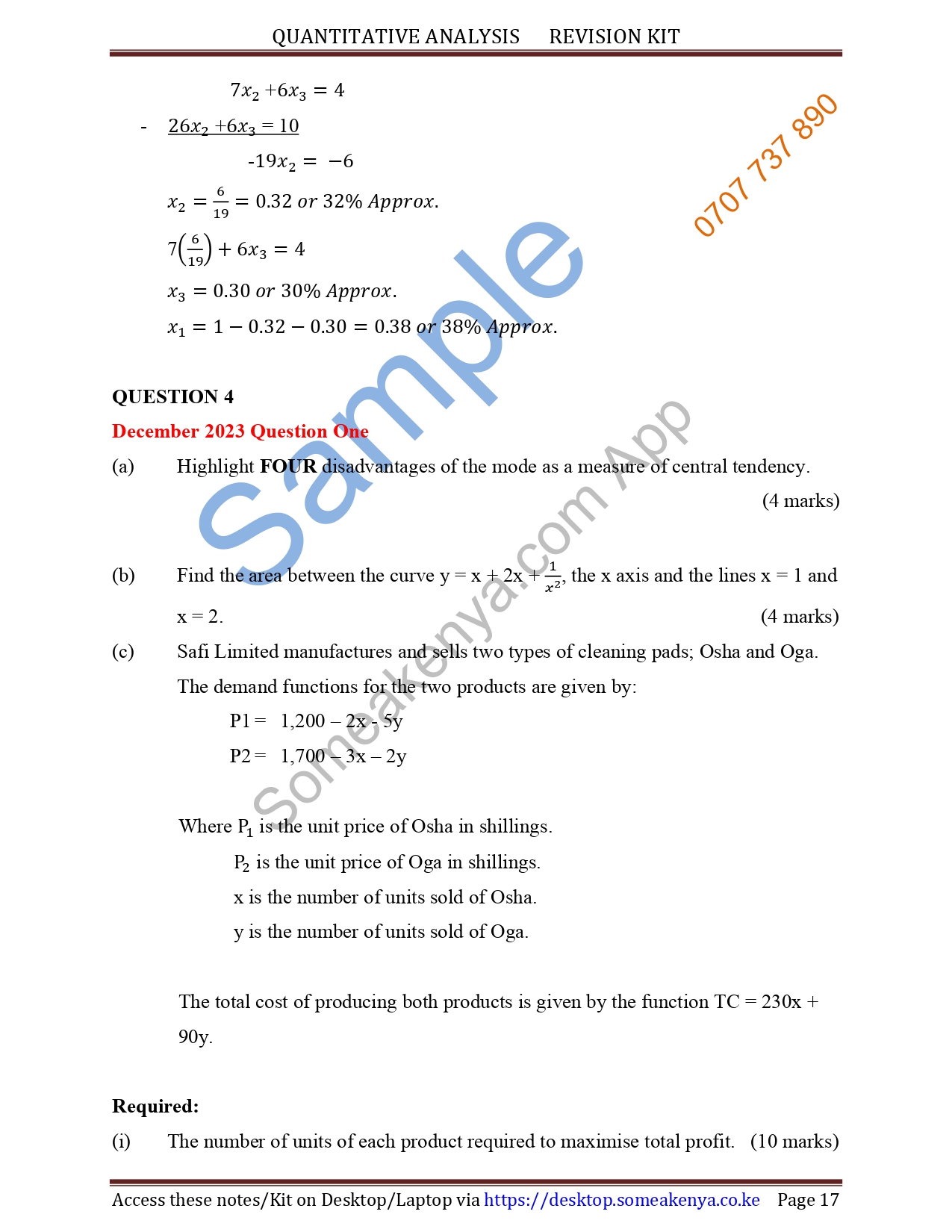
Past papers exam questions and answers
Revision is more than memorising facts and going over notes. You can practise an exam by answering CPA kasneb past exam questions from past papers. This will give you a better chance of passing.
By practising with real past examination papers you will:
- Find out if you have learnt enough to tackle CPA kasneb exams
- Identify any weakness that you may have in answering questions
- Learn about how the exam questions are answered.
Once you have completed a paper, you can compare your answers against the marking scheme. With the many past papers provided in our revision kits you will increase your chance of passing the upcoming exams.
Quantitative Analysis (QA) Revision Kit – Past exam questions and answers for kasneb CPA, CIFA and CCP courses
This revision kit consists of kasneb past paper questions and their suggested answers to act as a revision guide for those students taking kasneb courses.
Full Access to these notes/Kit on Desktop/Laptop via https://desktop.someakenya.co.ke
Or through Our Mobile App








Full Access to these notes/Kit on Desktop/Laptop via https://desktop.someakenya.co.ke
Or through Our Mobile App
PAPER NO. 5 QUANTITATIVE ANALYSIS
UNIT DESCRIPTION
This paper is intended to equip the candidate with knowledge, skills and attitudes that will enable the learner to use quantitative analysis tools in business operations and decision making.
LEARNING OUTCOMES
A candidate who passes this paper should be able to:
- Use mathematical techniques to solve business problems.
- Apply set and probability theories in business decision making
- Apply operation research techniques in decision making
- Apply hypothesis testing in analysing business situations
- Apply linear programming to solve practical business problems
CONTENT
- Mathematical Techniques
1.1 Functions
1.1.1 Definition
1.1.2 Functions, equations, inequalities and graphs; linear, quadratic, cubic, Exponential and logarithmic functions
1.1.3 Application of mathematical functions in solving business problems
1.2 Matrix Algebra
1.2.1 Definition
1.2.2 Types and operations (addition, subtraction, multiplication, transposition and inversion of up to order 3×3)
1.2.3 Application of matrices; statistical modelling, Markov analysis, input-output analysis and general applications
1.3 Calculus
1.4 Differentiation
1.4.1 Definition
1.4.2 Rules of differentiation (general rule, chain, product, quotient)
1.4.3 Differentiation of exponential and logarithmic functions
1.4.4 Turning points (maxima, minima and inflexion)
1.4.5 Application of differentiation to business problems
1.5 Integration
1.5.1 Definition
1.5.2 Rules of integration (general rule)
1.5.3 Integration of exponential and logarithmic functions
1.5.4 Applications of integration to business problems
1.6 Descriptive Statistics
1.6.1 Measures of central tendency: mean: arithmetic mean, weighted arithmetic mean; geometric mean, harmonic mean, median and mode
1.6.2 Measures of dispersion: range, quartile, deciles, percentiles, mean deviation, standard deviation and coefficient of variation
1.6.2.1 Measures of skewness: Pearson’s coefficient of skewness, product coefficient of skewness
1.6.2.2 Measures of kurtosis: Pearson’s coefficient of kurtosis, product coefficient of kurtosis
- Probability
2.1 Set Theory
2.2 Definition
2.3 Types of sets
2.4 Set description; enumeration and descriptive properties of sets
2.5 Venn diagrams (order – Venn diagrams precede operation of sets)
2.6 Operations of sets; union, intersection, complement and difference
2.7 Probability Theory and Distribution
2.7.1 Probability Theory
2.7.2 Definitions; event, outcome, experiment, sample space, probability space
2.7.3 Types of events: elementary, compound, dependent, independent, mutually exclusive, exhaustive, mutually inclusive
2.7.4 Laws of probability; additive and multiplicative laws
2.7.5 Conditional probability and probability trees
2.7.6 Expected value, variance, standard deviation and coefficient of variation using frequency and probability
2.7.7 Application of probability and probability distributions to business problems
2.8 Probability Distributions
2.8.1 Discrete and continuous probability distributions Z, F, test statistics (geometric, uniform, normal, t distribution, binomial, Poisson and exponential and chi-square)
2.8.2 Application of probability distributions to business problems
- Hypothesis Testing and Estimation
3.1 The arithmetic mean and standard deviation
3.2 Hypothesis tests on the mean (when population standard deviation is unknown)
3.3 Hypothesis tests on proportions
3.4 Hypothesis tests on the difference between two proportions using Z and t statistics
3.5 Chi-Square tests of goodness of fit and independence
3.6 Hypothesis testing using R statistical software
- Correlation and Regression Analysis
4.1 Correlation Analysis
4.1.1 Scatter diagrams
4.1.2 Measures of correlation – product-moment and rank correlation coefficients (Pearson and Spearman) using R software
- Regression Analysis
5.1.1 Simple and multiple linear regression analysis
5.1.2 Assumptions of linear regression analysis
5.1.3 Coefficient of determination, standard error of the estimate, standard error of the slope, t and F statistics
- Time series
6.1 Definition of time series
6.2 Components of time series (circular, seasonal, cyclical, irregular/ random, trend)
6.3 Application of time series
6.4 Methods of fitting trend; freehand, semi-averages, moving averages, least-squares methods
6.5 Models – additive and multiplicative models
6.6 Measurement of seasonal variation using additive and multiplicative models
6.7 Forecasting time series value using moving averages, ordinary least squares method and exponential smoothing
- Linear programming
7.1 Definition of decision variables, objective function and constraints
7.2 Assumptions of linear programming
7.3 Solving linear programming using graphical method
7.4 Solving linear programming using simplex method (basic scenarios)
- Decision Theory
8.1 Definition
8.2 Decision-making process
8.3 Decision-making environment; deterministic situation (certainty)
8.4 Decision making under risk – expected monetary value, expected opportunity loss, risk using the coefficient of variation, the expected value of perfect information
8.5 Decision trees – sequential decision, the expected value of sample information
8.6 Decision making under uncertainty – maximin, maximax, minimax regret, Hurwicz decision rule, Laplace decision rule.
I have tried to access the app bt I can’t register it’s nt reposponding
how much does it cost to get the notes and revision kit
how much